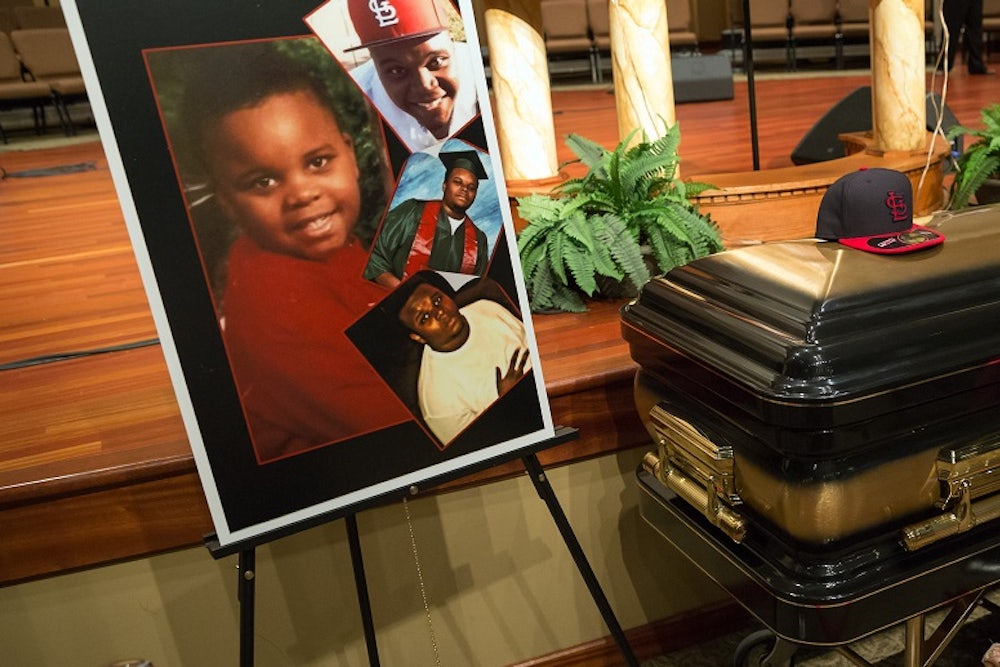More than two months have passed since Officer Darren Wilson shot and killed Michael Brown on the streets of Ferguson, Missouri—setting off confrontations between (mostly African-American) residents and (mostly white) police, and sparking a national conversation about race. But the precise circumstances of what happened on that August afternoon remain unclear to this day. The key issue is whether Wilson fired in self-defense, as he told investigators, or whether he fired without sufficient provocation. On Wednesday, new evidence emerged, thanks to a Washington Post investigation and an autopsy report from the county medical examiner. The evidence isn’t conclusive, but it lends more credence to Wilson’s version of events.
To review, there’s not much dispute about how the incident started: Wilson pulled up along Brown and his friend Dorian Johnson, who were walking in the middle of a street. At that point, an altercation occurred—and that’s where accounts start to diverge. Wilson’s version of the story, relayed through leaks of testimony and official police department statements, goes like this: Brown refused to let Wilson exit his vehicle and punched the officer multiple times in the face. According to Wilson, Brown then lunged for the officer’s gun and the two fought for it until Wilson fired twice. At that point, Brown ran the other direction and Wilson ordered him to lower himself to the ground. Instead, Wilson says, Brown turned and began charging at the officer. Since Brown was 6-foot-4 and weighed nearly 300 pounds, Wilson feared for his life and fired the fatal shots.
Multiple eyewitnesses, including Johnson, have described events differently. Wilson, they say, grabbed Brown by the neck and pulled him into the car. After the two shots were fired, Brown took off in the other direction, but stopped and tried to surrender as Wilson pursued him. While Brown had his hands in the air—the “hands up, don’t shoot” motion that was frequently used by protesters in the ensuing days—Wilson shot and killed him.
The county autopsy report, which was one of three autopsies performed on Michael Brown’s body, confirms much of what was already known. It showed that the fatal bullet struck Brown in the top of the head, indicating that he was facing Wilson with his head angled downwards at that moment. Police also found two bullet casings inside the car, apparently confirming that Brown was standing at the driver’s side window during the original altercation. These are important details, but they could be consistent with either version of events.
But other pieces of new evidence would appear to bolster Wilson’s side of the story. The county autopsy report shows material “consistent with products that are discharged from the barrel of a firearm” in a wound on Brown’s hand. That would indicate Brown’s arm was near Wilson's gun when he fired the first two shots, forensic experts told the St. Louis Post-Dispatch. Sources also told The Washington Post that “blood spatter evidence shows that Brown was heading toward the officer during their face-off.” In addition, the county autopsy showed that the sixth shot to strike Brown took a trajectory—entering the forearm from the back, traveling into the inner arm from there—that’s inconsistent with Brown having his arms in the air, palms facing outward, in an attempt to surrender. Finally, the Post reports that “seven or eight African American eyewitnesses have provided testimony consistent with Wilson’s account, but none of them have spoken publicly out of fear for their safety.”
This official autopsy does have one key difference with the private one that Dr. Michael Baden carried out at the request of the Brown family. In August, Baden reported that he found no gunpowder residue on Brown, indicating that the nuzzle of Wilson’s gun was “at least one or two feet away.” It's not clear why Baden didn't detect gun residue and the county medical examiner did; they may not have performed the same tests, or had access to the same information. But it's a discrepancy with potentially important implications, because a lack of gunpowder could undermine Wilson's version of the story.
How much stock you put in these results depends, in part, on how much you trust the county medical examiner’s office and the sources who spoke to the Post. The Brown family didn’t trust local authorities at all—that’s why they asked for a private autopsy in the first place. “The family has not believed anything the police or this medical examiner has said,” a lawyer for the family told The Washington Post. “They have their witnesses. We have seven witnesses that we know about that say the opposite.” In addition, we don't know much of the evidence that has been presented to the grand jury. These leaks are only part of the story. The Department of Justice, for its part, also condemned the leaks Wednesday, saying, "There seems to be an inappropriate effort to influence public opinion about this case.”
The grand jury is expected to reach a conclusion on whether to indict Officer Wilson next month. But its decision may not settle the question of what actually happened in Ferguson on that August day. Quite possibly nothing ever will.
Update: I added the DOJ statement.
